| Line 380: | Line 380: | ||
|} |
|} |
||
| − | ==== Temperate |
+ | ==== Temperate biomes ==== |
In these verdant biomes, it begins snowing over the 256 block height limit, snow does not generate naturally. Otherwise, it rains. The foliage and grass is a vibrant <span style='color:ForestGreen'>light green</span>, except for swamps and dark forests, which have dark green grass. Rivers and birch forests are also exempt from this, as they have a dull aqua hue. The water is <span style='color:blue'>blue</span> in this biome. |
In these verdant biomes, it begins snowing over the 256 block height limit, snow does not generate naturally. Otherwise, it rains. The foliage and grass is a vibrant <span style='color:ForestGreen'>light green</span>, except for swamps and dark forests, which have dark green grass. Rivers and birch forests are also exempt from this, as they have a dull aqua hue. The water is <span style='color:blue'>blue</span> in this biome. |
||
| Line 685: | Line 685: | ||
|} |
|} |
||
| − | ==== Dry |
+ | ==== Dry biomes ==== |
{{Redirect|Plateau|the ''Minecraft Dungeons'' location|MCD:Panda Plateau}} |
{{Redirect|Plateau|the ''Minecraft Dungeons'' location|MCD:Panda Plateau}} |
||
Revision as of 21:45, 11 April 2021

A river going through a jungle.

A river running through badlands.

A river running through a giant tree taiga.

A Shattered Savanna biome, a variant of the Savanna biome.

A rare division of extremely cold biomes with extremely hot biomes.

A warm ocean biome with a coral reef visible.
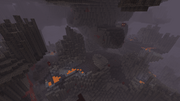
A Basalt Delta, found in the Nether.

The temperature influences the shades of green for the grass, and of blue for the water.
A biome is a region in a world with distinct geographical features, flora, heights, temperatures, humidity ratings, and sky and foliage colors. Biomes separate every generated world into different environments, such as forests, jungles, deserts, and taigas.
Temperature
Biomes have a temperature value that determines if it snows or rains. The required temperature values are less than 0.15 for snow, and above 0.15 for rain. The temperature also drops 0.0016 (1⁄625) per meter above the default sea level (Y=64), but does not change below sea level. These values can be used to determine the heights that snow generates at in different biomes. For example, mountains generate snow at Y=95, due to their highland climate, as their temperature value is 0.2. The temperature affects only the transition from rain to snowfall. All the biomes in vanilla with a temperature above 0.95 (and by extent, all the dry biomes) are hardcoded to never have precipitation at any height or temperature. For example, savannas do not experience rain or snow due to their heat. If a biome with a temperature above 0.95 is edited to allow precipitation through a data pack or mod, it simply behaves like a normal rainy biome.
Biomes are split into 5 categories based on their temperature: snow-covered, cold, temperate/lush, dry/warm, and neutral. They are almost always separated during terrain generation to prevent biomes with huge temperature differences being placed side-by-side (such as a snowy taiga next to a desert), and to allow biomes with similar temperatures to be placed next to each other more often (such as forests and swamps).
Generation
Minecraft biomes are generated in layer stacks. These layers generate specific aspects of Minecraft biomes, such as scale, rivers, mutated biomes, and biome categories.
Earlier stages
Biome generation is initialized as a 1 to 4096 scale of ocean, with a few spots of landmasses scattered throughout. This map is then scaled and additional landmasses shuffled around to decrease the amount of ocean, twice, to reach a scale of 1 to 1024. Additional layers that decrease the amount of ocean are repeatedly applied until the ratio of land to ocean is about 50-50. Snowy biome categories are then assigned to a few spots of land, which is then shuffled around a final time to obtain a ratio of 33% ocean and 67% landmass.
At this stage of biome generation, the final climate zones are applied as follows. Areas of warm landmasses are assigned to be a lush biome if it borders a cool or frozen landmass. Areas of snowy landmasses are assigned to the cool/temperate temperature category if it borders a lush or hot temperature zone. 1 out of every 13 landmasses is then marked as "Special", which would be used to place some of the rarer biomes in later stages of biome generation. This map is then scaled twice, until a scale of 1 to 256. An additional layer is applied to create a more jagged coastline, creating areas of large islands and lakes around the coastline. 1 out of 100 areas of Oceans are assigned as Mushroom biomes and areas of ocean far from the coast converted into Deep Ocean.
The final areas of climate areas are as follows: 31% Ocean, which consists of 22% Deep Ocean and 9% Ocean, 0.07% Mushroom, 13% Hot/Dry, 22% Lush/Warm, 23% Cool/Temperate, and 6% Frozen/Snowy. Areas of rare biomes make up 4% of the total area.
The biome generation is then split into 3 separate stacks.
Generation of biomes and biome variants
One stack of biome generation generates the actual biomes in-game. The biome categories generate the following biomes as follows. Some biomes are weighed more and as such generate more commonly, than other biomes. Snowy biomes have an unused rare biome variant, and as such generate as normal snowy biomes.
- Hot/Dry Biomes: Desert (3 times), Savanna (2 times), Plains
- Hot/Dry Biomes (rare): 1/3 Badlands Plateau, 2/3 Wooded Badlands Plateau (0.9% of the final map)
- Lush/Warm Biomes: Forest, Dark Forest, Mountains, Plains, Birch Forest, Swampland
- Lush/Warm Biomes (rare): Jungle (1.5% of the final map)
- Cool/Temperate Biomes: Forest, Mountains, Taiga, Plains
- Cool Temperate Biomes (rare): Giant Tree Taiga (1.6% of the final map)
- Snowy/Frozen Biomes: Snowy Tundra (3 times), Snowy Taiga (1 time)
Forest and Mountain biomes can generate in both cool/temperate biome clusters in addition to lush/warm temperature clusters. Plains biomes can generate in all temperature clusters except in frozen/snowy biomes.
Since Village and Pillage, Bamboo Jungles overwrite certain areas of Jungle Biomes.
This map is scaled twice until a scale of 1 to 64 in both Java and Bedrock Editions. In Legacy Console Edition, the map is not scaled at all at this stage of biome generation. To ensure a smooth transition between biomes, some biomes generate an "edge biome" as follows. These edge biomes can also generate hills and modified biome variants:
- Badlands Plateau and Wooded Badlands Plateau generate regular Badlands on all edges.
- Giant Tree Taiga generates the regular Taiga on all edges, unless there is a pre-existing Snowy Taiga or Taiga bordering it.
- If a Desert borders a Snowy Tundra, a Wooded Mountains can generate.
- If a Swamp borders a Jungle, a Jungle Edge can generate. If a Swamp borders a Desert or Snowy Tundra, a Plains biome generates.
Modified and hill biomes are then merged into the biome generation. Most biomes have a "hills" variant but some biomes use other biomes as their "hills" variant, which are listed below. This stage also allows islands to generate in areas of Deep Ocean:
- Dark Forest -> Plains
- Plains -> 1/3 Wooded Hills, 2/3 Forest
- Snowy Tundra -> Snowy Mountains
- Ocean -> Deep Ocean
- Savanna -> Savanna Plateau
- Deep Ocean -> 1/2 Plains, 1/2 Forest
- Wooded Badlands Plateau and Badlands Plateau -> Regular Badlands
Swamps and regular Badlands do not generate a hills biome variant. Oceans do not have a "modified" biome variant. While most biomes have a "modified" variant, few biomes generate a unique "modified hills" variant, such as Birch Forests and Mountain biomes. Some other biomes use another existing biome as a "modified hills" variant. If a biome does not have a "modified hills" variant, such as Swamps or Snowy Taigas, the regular biome variant generates instead.
Additional areas of Sunflower Plains are generated separately to the modified biome stage of biome generation, covering 1/57 of normal Plains biome.
The map is then scaled and the coastline made more jagged, then scaled again and beaches are generated. The generation of shorelines and beaches are as follows, this also adds a few additional biome edge biomes for Jungles and Badlands, without biome variants:
- Beaches generate on all coastlines except the regular Swamp and regular Badlands biomes.
- Stone Shore generates on the coastline of the regular Mountains and Wooded Mountains biomes.
- Snowy Beaches generate on the coastline of all Snowy Tundra and Snowy Taigas, including their variants.
- Mushroom Field Shore generates on the coastline of all Mushroom Fields biomes.
- a regular Desert Biome generates on the edge of all Badlands biomes, excluding eroded Badlands.
- A Jungle Edge biome generates on the edge of all Jungles biomes, unless it borders a regular Forest or regular Taiga.
This also creates unique quirks in generation, where Gravelly Mountains and Swamp Hills generate a regular Beach biome, and Swamp Hills bordering a regular Jungle Edge, with a Modified Jungle Edge bordering Jungles.
This biome map is scaled two more times (scaled 4x) until a scale of 1 to 4. River generation is merged with the regular biomes, then ocean climate zones merged.
Generation of rivers and hills
A layer stack for river noise generation is used as a random number generator to generate areas of hills and mutated biomes, which is scaled twice before applied to the biome stage of biome generation at scale 1 to 64. Since Update Aquatic, Mutated biomes conform to an entire biome or can border a river. A separate layer stack to generate rivers throughout is scaled 4 times, before it is merged with the rest of the generation at scale 1 to 4.
Rivers generate across all land biomes excluding areas of Oceans. Frozen Rivers replace rivers in regular Snowy Tundras. Mushroom Field Shore generates in place of rivers in Mushroom Fields biomes.
Once the Ocean temperature stack and river generation stack is merged with the biome generation stack, a final layer is applied to make the biome scale 1:1, which is the final biome generation used in Minecraft.
Ocean temperature generation
This applies to Java Edition since Update Aquatic only.
Ocean biomes generate their climate zones separately from land biome generation, to avoid changing existing Minecraft seeds/biome generation in its entirely. Ocean climate zones are initialized at a scale of 1 to 256, then scaled 6 times, before it is merged with the rest of the biome generation.
In Java Edition, ocean climate areas are done so Warm Oceans cannot border Frozen Oceans. One must go incrementally from Warm Oceans, to Lukewarm Oceans, regular Oceans, and Cold Oceans, before reaching Frozen Oceans.
If a Frozen Ocean or Frozen Deep Ocean borders a land biome, a regular Cold Ocean generates. If a Warm Ocean generates next to a land biome, a regular Lukewarm Ocean generates. Warm Oceans overwrite Deep Oceans as Warm Deep Oceans do not generate.
Ocean climate zones are based off the 48 bit seed, unlike the rest of the land biome generation, as such, shadow seeds in Java edition contain entirely different ocean climate areas, even though common land biomes generate identically in Java Edition shadow seeds.
Other information
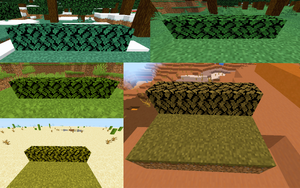
The five general shades of green for grass blocks and leaves, clockwise from top right: aquamarine (cold, ocean, and birch forest), brown (for badlands, which is a rare dry biome), olive (dry), green (temperate), and blue-grey (snowy).
In Java Edition, the possible shapes of biomes can use only the first 24 bits of the 64-bit world seed, and biome shapes within a world seed can repeat beginning around 229 blocks from 0,0. Biome generation overflows at 231 blocks from 0,0. However, as biomes are generated in a zoomed out stage, before it is scaled upwards, it technically means that biome generation could extend further out during earlier stages of biome generation as the integer overflow point is further out.
Even though there are 64-bit seeds on Java, there are only 263 unique noise maps for continental/ocean biome generation, due to a use of a quadratic equation in biome generation. This is colloquially known as a shadow seed. In this case, land biome and general ocean biomes are exactly the same in a pair of seeds, but ocean biome temperatures, structures, and hills differ in the shadow seed. A user can find a shadow seed by adding the constant -7379792620528906219 to their current world seed, to obtain the shadow seed. Shadow seeds are exclusive to Java Edition.
With Bedrock Edition using 32-bit seeds and a different world generation algorithm, there are few similarities between it and the 64-bit world generation. The positions of Mutated biomes, oceans (and islands), rare biomes (jungles, badlands, mushroom fields, giant tree taiga), as well as specific biomes in cold, temperate, or dry biome clusters, bear some geographical relationship with the equivalent positive value seed of the 64-bit generation. The biome shapes deviate significantly. The specific generation of lush biomes and ocean variants is completely different on Bedrock.
Biome types

Depending on the climate zone, the sky has a different tone: warm, temperate, cold or snowy.
In Java Edition, currently, there are 67 Overworld biomes, 5 Nether biomes, 5 End biomes, and 2 unused biomes, with a total of 79 different biomes. In Bedrock Edition, however, there are 66 Overworld biomes, 5 Nether biomes, 1 End biome, and 3 unused biomes, with a total of 75. Biomes can be distinguished by the grass, and leaf colors (water color also differ between biomes in the biome, along with the types of blocks present (e.g. types of trees or other plants like cacti, sand coverage in deserts)). Biomes are pseudo-randomly generated using the map seed.
Biomes are separated into 6 temperature classes. The snowy ones have their temperature listed in purple, cold in green, temperate/lush in orange, dry/warm in red, and the end in blue. The biomes of either neutral or unknown temperature have no temperature class. Temperatures are given at sea level.
Overworld
Snowy biomes
In these biomes, it always snows instead of rains and no matter the height; all sources of water exposed to the sky are frozen over. The foliage and grass is aqua, and the water is purple.
| Biome Name and ID | Features | Description | Screenshot of biome |
|---|---|---|---|
Snowy Tundra 12 |
Temperature: 0.0 Snow, Snowfall, Oak trees,[Java Edition only] Ice, Spruce trees, Igloos, Strays, White and some Black & White Rabbits, Polar Bears, Occasional Tall Grass, Villages, Pillager outposts |
An expansive, hilly biome with a huge amount of snow layers. Sugar cane can generate in this biome, but can become uprooted when chunks load as the water sources freeze to ice. There are few natural oak[Java Edition only] and spruce trees in this biome. No animal mobs other than rabbits and polar bears are able to spawn, however, it is one of the few biomes where strays appear, a hostile mob similar to skeletons, except they shoot arrows of slowness. In Bedrock, this biome doesn't spawn monsters other than strays and skeletons, but spawners can still spawn monsters. Due to the biome's size and scarcity of wood and animals, initial survival becomes difficult in comparison to other biomes. This is one of only two biomes where igloos naturally generate. Villages and pillager outposts may also generate here. | 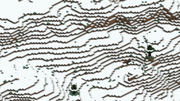 Snowy Tundra |
Ice Spikes 140 |
Temperature: 0.0 Packed Ice, Ice, Snow, Snowfall, Snow Blocks, Strays, White and some Black & White Rabbits, Polar Bears, Ice Spikes |
A rare variation of the Snowy Tundra biome that features large spikes and glaciers of packed ice. Usually, the spikes are 10 to 20 blocks tall, but some long, thin spikes can reach over 50 blocks in height. Glaciers replace lakes and are called Ice Patches in code. Almost all grass blocks in this biome are replaced with blocks of snow but occasional grass blocks can be found in hollows and under overhangs. Tall grass is rare. Like the regular snowy tundra, no animal mobs other than rabbits and polar bears are able to spawn and strays appear at night. | 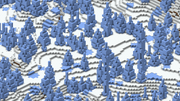 Ice Spikes |
Snowy Taiga 30 |
Temperature: -0.5 Snow, Snowfall, Ice, Spruce Trees, Flowers, Wolves, White and some Black & White Rabbits, Foxes, Igloos, Villages[Bedrock Edition only], Pillager outposts, Sweet berry bushes |
Much like the regular Taiga, the "Snowy Taiga" has large expanses of spruce trees, ferns, and their taller variants, generate here commonly, although tall grass can still be found. It is one of the few places where wolves and foxes spawn naturally. One may also find an igloo nestled between the trees from a more or less flat terrain, making it one of only two biomes where igloos naturally generate. Villages[BE only] and outposts[BE only] may also generate here. Villages use the same architecture as taiga villages but the villagers wear snowy biome outfits. |
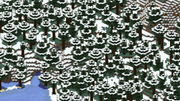 Snowy Taiga |
Snowy Taiga Mountains 158 |
Temperature: -0.5 Spruce Trees, Snow, Snowfall, Ferns, Wolves, Sweet berry bushes, Foxes, White and some Black & White Rabbits |
The Snowy Taiga Mountains are not nearly as flat as their regular counterpart. Compared to the regular Taiga Mountains, the mountains found in this biome are much steeper and more erratic. These large height differences make navigating the snowy taiga mountains biome quite dangerous. Also unlike their normal variant, igloos, villages and outposts do not generate here. |
 Snowy Taiga Mountains |
Frozen River 11 |
Temperature: 0.0 Ice, Water, Sand, Clay, Seagrass, Rabbit, Polar Bear, Salmon, Drowned, Stray |
A river with a layer of ice covering its surface. It generates only when a River biome enters or meets a Snowy Biome. Salmon spawn underwater while rabbits and polar bears spawn on ice. At night, Drowned can spawn below the ice with Strays on the surface. No other monsters can spawn here, even underground, except in a spawner[BE only]. |
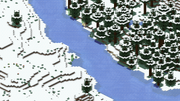 Frozen River |
Snowy Beach 26 |
Temperature: 0.05 Sand, Snow, Snowfall, Ice, Buried Treasure, Shipwreck, rabbit |
Like a regular beach, one can find plenty of sand in this biome and buried treasure can be found underground in this snowy beach. However, sand is covered in a layer of snow. Snowy beaches are often found when a snowy biome borders an ocean biome. No passive mobs other than rabbits spawn in this biome. |
 Snowy Beach |
Cold biomes
In these biomes, it begins to snow above y=90 in mountains and stone shore, above y=120 in taiga and giant spruce taiga, and above y=150 in giant tree taiga. Otherwise, it rains. Foliage is aqua as in snowy biomes, with the water being indigo.
| Biome Name and ID | Features | Description | Screenshot |
|---|---|---|---|
Mountains 3 |
Temperature: 0.2 Oak Trees[JE only], Spruce Trees[JE only], Gravel, Flowers, Emerald Ore, Infested Stone, Llamas |
A highland biome with some mountaintops reaching y=130, with a few scattered oak and spruce trees. Cliffs, peaks, valleys, waterfalls, overhangs, floating islands, caverns, and many other structures exist here, offering outstanding views. This is one of the few biomes where llamas can spawn naturally. Snowfall also occurs above certain heights up the mountain, thus creating snow layers on the top of the mountains. Falling is a significant risk, as there are many steep ledges large enough to cause severe fall damage or even death. Mountains are the only biomes where emerald ore (underground) and silverfish (in infested stone) can be found naturally. Trees cannot generate here In Bedrock Edition and Minecraft Education |
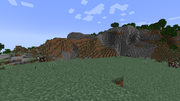 Mountains |
Gravelly Mountains 131 |
Temperature: 0.2 Spruce Trees[JE only], Oak Trees[JE only], Gravel, Llama, Emerald ore, Infested stone, Snow |
The mountains in this biome are slightly higher than in their regular counterpart[JE only], many of which reach into the clouds and are covered by snow peaks. The gravelly mountains are mostly gravel with maybe some grass. Due to the low amount of grass, the population of spruce and oak trees in this biome is sparse. When generating alongside an Ocean Biome, it can generate cold or normal beaches. |
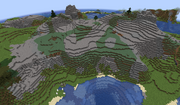 Gravelly Mountains. |
Wooded Mountains 34 |
Temperature: 0.2 Stone, Dirt, Llama, Emerald ore, Infested stone, Spruce Trees, Oak Trees |
This biome, usually found in the middle of regular mountains biome, generates much taller mountains then the regular mountain biome mountains, most of these mountians are covered by snow. The slopes are quite steep, which makes scaling these mountains difficult and dangerous. The peaks feature much more grass and spruce trees than the Gravelly Mountains, usually forming a small forest at the top. |
 Wooded Mountains |
Gravelly Mountains+ 162 |
Temperature: 0.2 Spruce Trees, Oak Trees, Gravel, Llama, Emerald ore, Infested stone, Grass |
This variant of the Wooded Mountains biome removes its signature spruce tree covered peaks in favor of terrain covered mostly by gravel and stone, similar to the Gravely Mountains biome. Larger, deeper valleys are carved into the relatively barren landscape - only a few isolated trees can be found here. Just like the Gravelly Mountains Biome, when generating alongside an ocean biome, beaches generate. |
 Gravelly Mountains+ |
Taiga 5 |
Temperature: 0.25 Spruce Trees, Flowers, Fern, Wolves, Brown, salt & pepper and black rabbits, Villages, Pillager outposts, Foxes, Sweet berry bushes, |
A predominantly flat biome covered by a forest of spruce trees. Ferns, large ferns and berry bushes grow commonly on the forest floor. One can find packs of wolves here, along with small groups of foxes or rabbits. Villages may generate in this biome; the houses in these villages are built of spruce wood. Pillager outposts may also generate in this biome. | 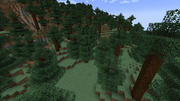 Taiga |
Taiga Mountains 133 |
Temperature: 0.25 Spruce Trees, Flowers, Ferns, Sheep, Brown, salt & pepper and black rabbits, Sweet berry bushes, Foxes |
The Taiga Mountains biome are like the regular taiga but with mountains, but these forests are overlayed onto mountainous terrain. Unlike Taiga Hills, these mountains tend to be larger then regular mountains and more difficult to climb. Perhaps owing to the rough nature of this biome, no villages nor outposts can be found here. |
 Taiga Mountains |
Giant Tree Taiga 32 |
Temperature: 0.3 Spruce Trees, Podzol, Ferns, Wolves, Brown, salt & pepper and black rabbits[JE only], Foxes, Mossy Cobblestone, Mushrooms, Dirt, Coarse Dirt, Dead Bush |
The Giant Tree Taiga is a rare cold biome composed of spruce trees, much like the standard Taiga biome. However, some trees are 2×2 thick and taller than normal, akin to large jungle trees. Mossy cobblestone boulders appear frequently, brown mushrooms are common, and podzol can be found on the forest floor. There are also patches of coarse dirt that do not grow grass, with some dead bushes. Wolves and foxes may also spawn here, as they do in normal Taiga biomes. Rabbits may also spawn here in Java Edition. |
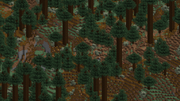 Giant Tree Taiga |
Giant Spruce Taiga 160 |
Temperature: 0.25 Spruce Trees, Podzol, Ferns, Grass, Foxes, Wolf, Mossy Cobblestone, Mushrooms, Dirt |
The terrain in this rare biome is almost exactly the same as in its regular counterpart. However, the most striking feature of this biome is its giant spruce trees, which are essentially a scaled-up version of regular spruce trees. One can easily differentiate this from a normal Giant Tree Taiga by observing how the leaves almost completely cover the tree trunks, whereas, in normal Giant Tree Taigas, leaves tend to cover only the top. |
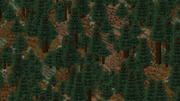 Giant Spruce Taiga |
Stone Shore 25 |
Temperature: 0.2 |
True to its name, this stone-covered biome often appears where mountain biomes meet the ocean. Depending on the height of the nearby land, Stone Shores may generate as medium slopes or huge cliffs, its tops tall enough to be covered by snow. No passive mobs spawn here. Buried treasure can generate here. No sand blocks can generate here. |
 Stone Shore |
Temperate biomes
In these verdant biomes, it begins snowing over the 256 block height limit, snow does not generate naturally. Otherwise, it rains. The foliage and grass is a vibrant light green, except for swamps and dark forests, which have dark green grass. Rivers and birch forests are also exempt from this, as they have a dull aqua hue. The water is blue in this biome.
| Biome Name and ID | Features | Description | Screenshot |
|---|---|---|---|
Plains 1 |
Temperature: 0.8 Tall Grass, Grass, Flowers, Villages, Horses, Donkeys, Pillager outposts, Oak Trees, Bee Nests |
A flat and grassy biome with rolling hills and few oak trees. Lakes, small underwater caves and villages are common. Cave openings, lava lakes and waterfalls are easily identifiable due to the flat unobstructed terrain. Farm mobs are easily found in Plains biomes; this biome and its variants are also one of the only biomes where horses spawn naturally. Pillager outposts may also be generated. | 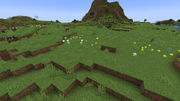 Plains |
Sunflower Plains 129 |
Temperature: 0.8 Grass, Sunflowers, Flowers, Donkeys, Villages[BE only], Pillager Outposts[BE only], Horses, Oak Trees, Bee Nests |
Found within normal plains, this biome is the only place where sunflowers naturally generate, hence the name. They grow in abundance, making yellow dye a widely available resource. | 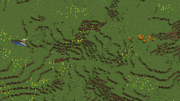 Sunflower Plains |
Forest 4 |
Temperature: 0.7 |
A small and common biome, with a lot of oak and birch trees, occasional hills and a fair amount of tall grass, mushrooms and flowers. This is one of the most preferred biomes to start out in, due to the abundance of wood. Like in taigas, wolves are found. | 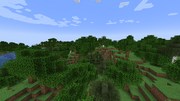 Forest |
Flower Forest 132 |
Temperature: 0.7 Flowers, Trees, Brown, salt & pepper and black rabbits, Bee Nests |
This Forest variant has fewer trees, but more than makes up for it - it is almost overflowing with nearly every type of flower and tall plant in the game, several of which grow only in this biome. Therefore, this biome is optimal for harvesting and farming dyes. Wolves do not spawn in the flower forest, although rabbits spawn occasionally. | 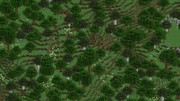 Flower Forest |
Birch Forest 27 |
Temperature: 0.6 |
A forest where the grass is aqua and only birch trees generate. Unlike in the regular Forest, no wolves spawn in this forest. | 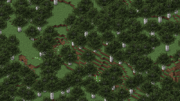 Birch Forest |
Tall Birch Forest 155 |
Temperature: 0.6 Tall Birch Trees, Flowers, Bee nests |
Birch trees grow much taller than usual in this uncommon variant of the Birch Forest biome. Whereas normal birch trees grow up to 7 blocks tall, these trees usually are 11 blocks in height. This makes deforestation a much more difficult task, although it provides the player with far more resources. Additionally, the terrain in this biome is much rougher and taller than birch forest hills. |  Tall Birch Forest |
Dark Forest 29 |
Temperature: 0.7 Dark Oak trees, Huge Mushrooms, Mushrooms, Rose Bushes, Woodland Mansions |
This biome is mainly composed of dark oak trees, a mostly closed roof of leaves, and occasional large mushrooms. Trees in this forest are so packed together, that it's dark enough for hostile mobs to spawn, even during the day. On rare occasions, a woodland mansion may spawn, making the Dark Forest the only biome (along with Dark Forest Hills) in which woodland mansions can be found. |  Dark Forest |
Dark Forest Hills 157 |
Temperature: 0.7 |
A variant of the Dark Forest where large hills dominate the canopy. While increased light in the forest means slightly fewer mobs, the steep cliffs lining this biome still make it dangerous to navigate on foot. Woodland Mansions may still generate here on rare occasions. |  Dark Forest Hills |
Swamp 6 |
Temperature: 0.8 Swamp Huts, Oak trees, Grass, Vines, Lily Pads, Clay, Mushrooms, Slimes, Huge Mushrooms[Bedrock Edition only], Fossils, Seagrass |
A biome characterized by a mix of flat areas around sea level and shallow pools of green water with floating lily pads. Clay, sand, and dirt are commonly found at the bottom of these pools. Trees are covered with vines and can be found growing out from the water. Mushrooms and sugar canes are abundant. Swamp Huts with a black cat and a witch generate exclusively in swamps. Slimes also spawn naturally at night, most commonly on full moons. Some zombies may end up underwater, which can transform them into drowned, making this an especially dangerous biome at night. Temperature varies within the biome, causing foliage and grass colors to vary.
In Bedrock Edition, huge mushrooms also spawn in this biome. Visibility is also lower when the player is underwater. |
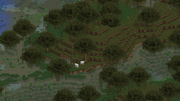 Swamp 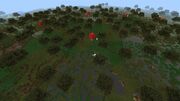 Swamp in Bedrock Edition |
Swamp Hills 134 |
Temperature: 0.8 Oak Trees, Vines, Lilypads, Huge Mushrooms[BE only], Water, Swamp huts[BE only], Fossils |
This rare variant of the Swamp biome has areas where small hills rise in slopes of varying degrees, surrounded by flatter marshes. Beaches generate when this biome borders an ocean biome. In Java Edition, Swamp huts do not generate in this biome, unlike the normal Swamp. |  Swamp Hills |
Jungle 21 |
Temperature: 0.95 Jungle trees, Oak trees, Jungle Pyramids, Ferns, Melons, Flowers, Vines, Cocoa, Ocelots, Parrots, Bamboo, Pandas[BE only] |
A dense and rare temperate biome. It features ferns and large jungle trees that can reach up to 31 blocks tall with 2×2 thick trunks. Oak trees are also common though. The landscape is lush green and quite hilly, with many small lakes often nestled into deep valleys, sometimes above sea level. Leaves cover much of the forest floor—these "bush trees" have single-blocks of jungle wood for trunks, surrounded by oak or jungle leaves. When inside a jungle, the sky becomes noticeably lighter as in dry biomes. Vines are found alongside most blocks and may cover the surface of caves. Ocelots, pyramids, melons, cocoa, pandas and parrots exclusively generate in this biome. Melons generate in patches, similar to pumpkins, but are common. | 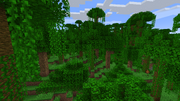 Jungle |
Modified Jungle 149 |
Temperature: 0.95 Jungle trees, Oak trees, Ferns, Melons, Flowers, Vines, Cocoa, Ocelots, Parrots, Bamboo, Pandas[BE only] |
Much more mountainous version of the normal Jungle, with foliage so thick that the ground is barely visible. This biome is demanding of a player's survival resources. One may confuse this with the Jungle Hills, but the hills in the Modified Jungle biome tends to be sharper and more erratic. Due to the combined height of the terrain and of the tall jungle trees, trees in this jungle frequently reach above the clouds. Extremely dense foliage and treacherous terrain make this biome difficult and dangerous to navigate, especially at night. |  Modified Jungle |
Jungle Edge 23 |
Temperature: 0.95 Jungle trees, Oak trees, Ferns, Melons, Flowers, Vines, Cocoa, Ocelots, Parrots, Bamboo, Pandas[BE only] |
This biome represents a smooth transition between jungles and other biomes. In stark contrast to the wild and overgrown vegetation of the jungle biomes, the jungle edge consists of a few small and isolated jungle trees, with patches of melons here and there. The terrain is relatively flat, with some small rises in elevation. All mobs that spawn in the Jungle, including parrots, ocelots, and pandas[Bedrock Edition only], also spawn in the Jungle Edge. | 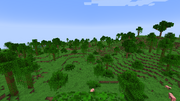 Jungle Edge |
Modified Jungle Edge 151 |
Temperature: 0.95 Jungle trees, Oak trees, Ferns, Melons, Flowers, Vines, Cocoa, Ocelots, Parrots, Bamboo, Pandas[BE only] |
The terrain in this biome is a slightly more hilly and rugged version of the normal Jungle Edge, though some large and flat sections of it are often hard to distinguish from its standard variant. Modified Jungle Edge is the rarest biome in the overworld and usually generates only when Jungle biomes meet Swamp Hills biomes. The result is a two-layer transition zone that includes a Modified Jungle Edge along the side of the Jungle, and a thin border of normal Jungle Edge on the side of the Swamp Hills. Jungles are already uncommon, and Swamp Hills are about 30 times rarer than regular Swamp, so it is extremely rare for them to generate bordering each other. The strict conditions that are needed for its generation also make it a small biome when it does occur, usually no longer than 150 blocks on its long side and less than that for width. This biome covers only about 1/370000 of the overworld by area. |  Modified Jungle Edge |
Bamboo Jungle 168 |
Temperature: 0.95 Jungle trees, Oak trees, Podzols, Vines, Ocelots[BE only], Jungle Pyramids[Java Edition only], Melons, Parrots, Bamboo, Pandas |
The terrain in this biome is covered by grass with some patches of podzol. Unlike the normal Jungle, bushes still generate but do not cover the floor. Additionally, only large jungle trees can generate here along with large or balloon oak trees. The density of trees in this biome is much less compared to jungle edge, but massive amounts of bamboo shoots generate covering this biome. Jungle exclusive mobs such as ocelots and parrots can spawn in here. Panda exclusively spawn in this biome[Java Edition only] or have a much higher spawn rate than in regular jungle.[Bedrock Edition only] Jungle pyramids can also generate.[Java Edition only] | 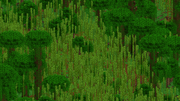 Bamboo Jungle |
River 7 |
Temperature: 0.5 Water, Sand, Clay, Sugar Cane, Seagrass, Salmon, Squid, Drowned |
A biome that consists of water blocks that form an elongated, curving shape similar to a real river. Unlike real rivers, however, they have no current. Rivers cut through terrain or separate the main biomes. They attempt to join up with Ocean biomes, but sometimes loop around to the same area of ocean. Rarely, they can have no connection to an ocean, instead of forming a loop. The grass has a dull aqua tone, much like the ocean, and trace amounts of oak trees tend to generate there as well. Rivers are also a reliable source of clay. These biomes are good for fishing, but drowned can spawn at night. Mobs other than salmon, squid and drowned cannot spawn in this biome, even underground, except in a spawner. | 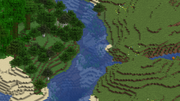 River |
Beach 16 |
Temperature: 0.8 Sand, Gravel, Water, Sugar Cane, Turtles, Buried Treasure, Shipwreck |
Generated where oceans meet other biomes, beaches are primarily composed of sand. Beaches penetrate the landscape, removing the original blocks and placing in sand blocks. These are also useful for fishing. Passive mobs other than turtles do not spawn on beaches. For the history of beaches, see the Beach page. | 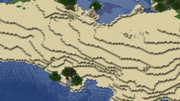 Beach |
Mushroom Fields 14 |
Temperature: 0.9 |
This rare biome consists of a mixture of flat landscape and steep hills and has mycelium instead of grass as its surface. However, any grass placed appears in a bright green color, even brighter than in the Jungle. Mushroom fields are most often adjacent to an ocean and are usually found isolated from other biomes, and they are typically a few hundred blocks wide. It is one of the only biomes where huge mushrooms can generate naturally, and where mushrooms can grow in full sunlight.
No mobs other than mooshrooms spawn naturally in this biome, including the usual night-time hostile mobs. This also applies to caves, mineshafts, and other dark structures, meaning exploring underground is safe. However, mob spawners still spawn mobs, wandering traders along with their llamas can spawn, raids can still spawn illagers, the player can still breed animals and spawn mobs using spawn eggs, and insomnia still attracts phantoms. |
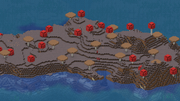 Mushroom Fields |
Mushroom Field Shore 15 |
Temperature: 0.9 Mushrooms, Huge Mushrooms, Mycelium, Mooshrooms, Buried Treasure, Shipwreck |
Mushroom Field Shores represent the transition between mushroom fields and the ocean, forming long strips between the biomes as a "beach", hence the name. However, it does not generate if the ocean biome is a Deep Ocean. This biome also generates when a river meets a Mushroom Fields biome, similar to what Frozen Rivers do in Snowy Tundras. The terrain of this biome is much more flat and shallow than the main Mushroom Fields biome, though it contains many of the same features, such as a mycelium surface layer, huge mushrooms, and lack of hostile mobs, but shipwrecks and buried treasure can generate here. |  Mushroom Field Shore |
Dry biomes
In these biomes, it neither rains nor snows at all, but the sky still turns overcast during inclement weather. The foliage and grass is an olive tone, except badlands biomes, which have brown grass. The water is light blue. As in jungle biomes, the sky becomes lighter. Additionally, a snow golem spawned or brought into one of these biomes melts unless it has the Fire Resistance effect.
| Biome Name and ID | Features | Description | Screenshot |
|---|---|---|---|
Desert 2 |
Temperature: 2.0 Sand, Cacti, Dead Bushes, Sandstone, Sugar Cane, Desert wells, Desert Pyramids, Desert Villages, Pillager Outposts, Gold Rabbits, Fossils, Husk |
A barren and inhospitable biome consisting mostly of sand dunes, dead bushes, and cacti. Sandstone, and sometimes fossils, are found underneath the sand. The only passive mobs to spawn naturally in deserts are gold/creamy rabbits, their coloring well-camouflaged against the sand. At night, husks usually spawn in the place of normal zombies; the lack of visual obstruction makes hostile mobs highly visible. Sugar cane can be found if the desert is next to an ocean or river biome. Desert villages, desert wells, and desert pyramids are found exclusively in this biome. Pillager outposts can also generate here. This biome sometimes appears as a thin edge around badlands biomes. |
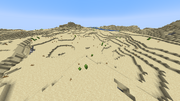 Desert |
Desert Lakes 130 |
Temperature: 2.0 Sand, Cacti, Water, Sugar Canes, Gold Rabbits, Desert well, Fossils, Husk |
In this biome, unlike the normal Desert, patches of water can be found, and the terrain is slightly more rough. Although desert wells can be found, desert pyramids, villages, and outposts do not generate in this biome. |
 Desert Lakes |
Savanna 35 |
Temperature: 1.2 Acacia Trees, Tall Grass, Savanna Villages, Horses, Cows, Pillager Outposts, Sheep, Llamas |
A relatively flat and dry biome with a dull-brown grass color and acacia trees scattered around the biome, though oak trees may generate now and then. Tall grass covers the landscape. Villages can generate in this biome, constructed of acacia wood, with some colored terracotta. Pillager outposts can also generate here. Both horses and llamas can naturally spawn here. |
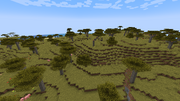 Savanna |
Shattered Savanna 163 |
Temperature: 1.1 |
Unlike the flat and calm terrain of the savanna biome, the chaotic terrain of this uncommon variant is covered in gigantic mountains covered in coarse dirt and some patch of stone. The mountains in the shattered savanna biome are extremely steep, jutting out at 90-degree angles, making it almost impossible to climb. Deep Ocean-like lakes also generate here. On top of that, they dwarf the mountains biome in height - they can rise far above the clouds, and even to the world height limit, without using the Amplified world type.[Java Edition only] Massive waterfalls and lavafalls are quite common here. The unforgiving terrain means villages and outposts do not generate in this biome. Surprisingly, llamas can naturally spawn here. In Bedrock Edition, shattered savannas are considered a temperate/lush biome, making foliage a vibrant green color and allowing rain to occur in them.[1] | 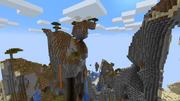 Shattered Savanna |
Badlands 37 |
Temperature: 2.0 Dead Bushes, Terracotta, Red Sand, Cacti, Red Sandstone[JE only], Above ground mineshafts, Gold ore |
A rare biome where large mounds of terracotta and stained terracotta generate. Red sand also generates here instead of regular sand, with occasional cacti and dead bushes, and this biome is usually bordered by a desert biome. No passive mobs spawn in this biome, even if all other spawning conditions are met. Mineshafts generate at a higher altitude than normal - occasionally a player may come across a mineshaft jutting out of the Badlands. Gold ore also occurs more frequently, because ore veins generate within badlands at a higher Y-level than the usual 32. The composition of this biome is useful when other sources of terracotta and gold are scarce. However, finding badlands biomes can be difficult due to their rarity. On the other hand, it offers great variety; six variations of this biome are available to explore.
|
 Badlands |
Eroded Badlands 165 |
Temperature: 2.0 Red Sand, Cactus, Red Sandstone[JE only], Dead Bushes, Terracotta, Above ground mineshaft, Gold ore |
This rare biome generates unique terrain features that are similar to the structures in Utah's Bryce Canyon. Tall and narrow spires of colorful terracotta rise out of the floor of the canyon, which like all other badlands variants, is covered in red sand. Deserts do not generate alongside this biome. |
 Eroded Badlands |
Wooded Badlands Plateau 38 |
Temperature: 2.0 |
One might not notice the difference between the normal badlands plateau and this variation, if it weren't for the layer of coarse dirt and the small forests of oak trees that generate atop these plateaus. The color of the grass and leaves is a dull green-brown hue, giving it a dried and dead appearance. These trees are a rare source of wood when living in the otherwise barren and lifeless badlands. |
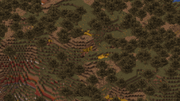 Wooded Badlands Plateau |
Modified Wooded Badlands Plateau 166 |
Temperature: 2.0 |
This biome features grass and oak trees on top of plateaus, much like its counterpart. However, the plateaus that generate here are generally smaller, allowing far less foliage to generate. The terrain is more erratic, and can be compared to that of the similar Modified Badlands Plateau biome, having an old and eroded appearance. Deserts do not generate alongside this biome. |
 Modified Wooded Badlands Plateau |
| Plateau(s) 36, 39 |
Temperature: |
Savanna plateau biomes are similar to the Hills biomes, but generate only within Savanna, while badlands plateau generate as actual biomes in Badlands biomes, and are flattened at the top, much like real-life plateaus. They come to rest at an elevation of about 20 to 30 blocks above sea level. One may discover the entrance to a mineshaft within the tall slopes of a Badlands Plateau. |
 Badlands Plateau 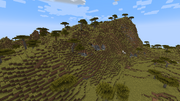 Savanna Plateau |
| Modified Plateau(s) 164, 167 |
Temperature: |
Two rare variants of the plateau biomes, which are variants themselves. However, neither of these biomes closely resemble their counterparts.
Compared to the average Badlands Plateau, the Modified Badlands Plateau features more variable terrain and smaller plateaus, as if a larger plateau was weathered down over time. It is the second-rarest biome in the game, after the Modified Jungle Edge. The terrain of the Shattered Savanna Plateau biome is much less tame than its normal counterpart. It features incredibly large and steep mountains that jut out of the terrain, similar to the Shattered Savanna biome, albeit slightly smaller and gentler in comparison. In Bedrock Edition, shattered savanna plateaus are considered a temperate/lush biome, making foliage a vibrant green color and allowing rain to occur in them.[1] |
 Modified Badlands Plateau  Shattered Savanna Plateau |
Ocean biomes
Oceans are large, open biomes made entirely of water going up to y=63, with underwater relief on the sea floor, such as small mountains and plains, usually including gravel. Oceans typically extend under 3,000 blocks in any direction; around 60% of the Overworld's surface is covered in ocean. Small islands with infrequent vegetation can be found in oceans. Passive mobs sometimes can spawn on these islands, as hostiles can. Squid spawn frequently in the water. Underwater cave entrances can be found frequently at the bottom of the ocean.
| Biome Name and ID | Features | Description | Screenshot |
|---|---|---|---|
Warm Ocean 44 |
Temperature: 0.5 Dolphins |
A variant of the Ocean biome, with light blue water at the surface. Like the Lukewarm Ocean, it has a floor made of sand, and like all oceans, it is populated with seagrass. Unlike other ocean biomes, Warm Oceans allow for the generation of coral reefs and sea pickles. Kelp cannot spawn here. | 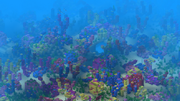 Warm Ocean |
Lukewarm Ocean 45 |
Temperature: 0.5 Dolphins, Pufferfish[JE only], Tropical fishes[JE only], Squid, Salmon[BE only] Cod, warm underwater ruins, Sand, Dirt, Clay, Drowned, Kelp, Seagrass, Shipwrecks, Magma blocks |
A variant of the Ocean biome, with light teal water at the surface. Its floor is made of sand with the occasional dirt or clay, kelp and seagrass spawn here. Unlike the Warm Ocean biome, cod and salmon[BE only] can spawn here. Coral cannot spawn here | 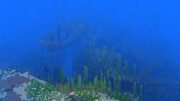 Lukewarm Ocean |
Deep Lukewarm Ocean 48 |
Temperature: 0.5 Dolphins, Pufferfish[JE only], Tropical fishes[JE only], Salmon[BE only] Cod, warm underwater ruins, Sand, Dirt, Clay, Drowned, Squid, Kelp, Seagrass, Ocean monuments, Guardians, Elder guardians, shipwrecks, Magma Blocks |
Similar to the Lukewarm Ocean biome, but twice as deep. Because they are a Deep Ocean variant, they can generate ocean monuments, resulting in the spawning of guardians, elder guardians, prismarine, and sponges. | 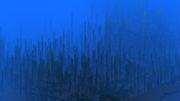 Deep Lukewarm Ocean |
Ocean 0 |
Temperature: 0.5 Water, Gravel, Squid, Sand, Seagrass, Kelp, Shipwreck, Cold Underwater ruins, Cod, Salmon[BE only], Drowned, Magma block |
The basic Ocean biome. Like its colder variants, its floor is made up of gravel. Sea grass, kelp, cod and salmon[Bedrock Edition only] can spawn here. |
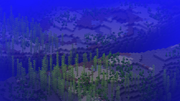 Ocean |
Deep Ocean 24 |
Temperature: 0.5 Water, Gravel, Clay, Squid, Guardians, Elder Guardians, Ocean monuments, Shipwreck, Cold underwater ruins, Kelp, Seagrass, Cod, Salmon, Drowned, Magma Block |
A variant of the Ocean biome. In Deep Ocean biomes, the ocean can exceed 30 blocks in depth, making it twice as deep as the normal ocean. The ground is mainly covered with gravel. Ocean monuments generate in deep oceans, meaning guardian and elder guardian can spawn here. Underwater ravines often generate here, with the top layer of lava being replaced by magma blocks that create bubble columns. |
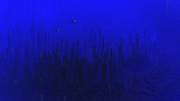 Deep Ocean |
Cold Ocean 46 |
Temperature: 0.5 Cod, Salmon, Cold underwater ruins, Gravel, Kelp, Seagrass, Dirt, Sand, shipwreck, magma blocks, squid, Drowned |
A variant of the Ocean biome, with dark indigo water at the surface. Like regular Oceans and Frozen Oceans, its floor is made up of gravel, though occasional patches of dirt can be found. Salmon are able to spawn in Cold Ocean biomes. | 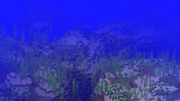 Cold Ocean |
Deep Cold Ocean 49 |
Temperature: 0.5 Cod, Salmon, Cold underwater ruins, Gravel, Kelp, Seagrass, Dirt, Sand, Ocean monuments, Guardians, Elder guardians, shipwrecks, Drowned, Squid |
Similar to the Cold Ocean biome, but twice as deep. Like other Deep Oceans, ocean monuments are able to generate here, which contain guardians, elder guardians, prismarine, and sponges. | 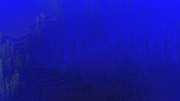 Deep Cold Ocean |
Frozen Ocean 10 |
Temperature: 0.0 Ice, Packed Ice, Blue Ice, Water, Gravel, Clay, Squid, Sand, Cod[BE only], Drowned, Salmon, Iceberg, Shipwreck, Cold underwater ruins, Stray, Polar Bear, Rabbit |
A variant of the Ocean biome with dark purple water at the surface. Like the Cold Ocean, it has a gravel seabed and squid swimming about. However, the water's surface is frequently broken up by patches of ice and large icebergs, consisting of packed ice and, occasionally, blue ice. Strays and polar bears can spawn here, but dolphins do not. |
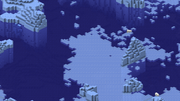 Frozen Ocean |
Deep Frozen Ocean 50 |
Temperature: 0.5 Salmon, Cold underwater ruins, Gravel, Ice[BE only], Packed Ice, Blue Ice, Ocean monuments, Guardians, Elder guardians, iceberg, shipwreck, Polar Bear, Stray, rabbit, cod[BE only], drowned, squid |
Like the Frozen Ocean biome, the only fish that can spawn here are salmon and cod[BE only], and the floor is made up of gravel. The Frozen Deep Ocean biome also contains ocean monuments and a deeper floor than normal Oceans, like other Deep Oceans. Unlike its shallow counterpart, the surface of the water is not frozen[JE only]. Frequent floating icebergs with blue ice generate here. Polar bears, rabbits, and strays can also spawn here, but dolphins do not. | 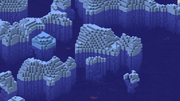 Deep Frozen Ocean |
Neutral biomes
| Biome Name and ID | Features | Description | Screenshot |
|---|---|---|---|
The Void[Java Edition only] 127 |
Temperature: 0.5 |
Can be accessed only through Buffet world selection or The Void superflat preset. In a Buffet world, the landscape consists only of stone, as well as water and bedrock depending on the generator type. In The Void superflat preset, the world is empty except for a single structure: a 33×33 stone platform with a single block of cobblestone in the center. No mobs (passive or hostile) can spawn without spawn eggs, spawners, or commands. |  The Void |
| Hills 13, 17, 18, 19, 22, 28, 31, 33, 156, 161, 169 |
Temperature: Same as their respective base biomes. |
Hills are generated within certain biomes (including some of their variants) and are referred in the F3 menu with Hills or Mountains added to their name.
This includes: Wooded Hills, Taiga Hills, Snowy Taiga Hills, Jungle Hills, Desert Hills, Birch Forest Hills, Tall Birch Hills, Giant Tree Taiga Hills, Giant Spruce Taiga Hills, Snowy Mountains, and Bamboo Jungle Hills. Most hills are gentle rolling slopes on which the usual biome terrain generates, with some sharper cliffs here and there. Snowy Mountains are usually taller, with height comparable to mountains biomes, and have a lower chance of spawning passive mobs during world generation than other biomes (7% versus 10%). Giant Spruce Taiga Hills are a special case. in Java Edition, the game code sets the values |
 Giant Tree Taiga Hills  Desert Hills  Jungle Hills  Snowy Mountains |
Unused biomes
These biomes don't generate in default worlds.
| Biome Name and ID | Features | Description | Screenshot |
|---|---|---|---|
Mountain Edge 20 |
Temperature: 0.2 Grass, Dirt, Stone, Llamas, Emerald ore, Infested stone, Spruce trees, Oak trees, Snow |
Similar to the jungle edge biome, the Mountain Edge used to generate exclusively at the edge of Mountain biomes in order to smooth the transition between biomes. This biome has lots of trees, similar to wooded mountains. While the terrain is lower and gentler in nature, some areas may reach high enough to be covered by snow. This biome doesn't generate naturally from Java Edition 1.7.2 onward. |  Mountain Edge |
Deep Warm Ocean 47 |
Temperature: 0.5 Dolphins, Pufferfish, Tropical fishes, Warm underwater ruins, Sand, Seagrass, Ocean monuments, Guardians, Elder guardians, shipwrecks |
Similar to the Warm Ocean biome, but without coral reefs nor sea pickles, and twice as deep. Because they are a deep ocean variant, they can generate ocean monuments, resulting in the spawning of guardians, elder guardians, prismarine, and sponges. | 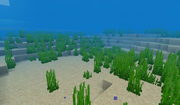 Deep Warm Ocean |
Legacy Frozen Ocean[Bedrock Edition only] -116 |
Temperature: 0.0 Polar Bears, Salmon, Cod, Strays, Cold underwater ruins, Gravel, Seagrass, kelp, Snowy Rabbits, Ice, shipwrecks |
Similar to the Frozen Ocean biome, but without icebergs, it is completely flat. Because they are a Frozen Ocean variant, they can spawn polar bears and strays, but not dolphins. Unlike the regular frozen ocean, Polar bear, drowned, squid, salmon, cod, Rabbits, skeletons and strays are the only mobs that spawn here. Kelp also generates here. This biome doesn't generate naturally from Pocket Edition Alpha 0.9.0 onward. |  Legacy Frozen Ocean |
Removed biomes
These biomes no longer generate in current versions of the game.
| Biome Name and ID | Features | Description | Screenshot |
|---|---|---|---|
Tundra |
Temperature: <50% |
Snowy, barren terrain with few trees. The occasional trees do exist, although rarely. Ice can be found over water. Snow is common weather in tundras. It generates when the temperature is below 50% and the rainfall is less than 20%. |
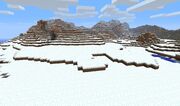 Tundra |
Rain Forest |
Temperature: >97% |
Rainforests are wet biomes with many trees, which have a 1 in 3 chance of being big, instead of 1 in 10 like all other biomes. They generate only oak trees and have a large amount of tall grass and ferns. A biome is classified as a rainforest if the temperature is greater than 97% and the rainfall is more than 90%. This could be the biome with some of the most cliffs and hills because the world generator reduces height variation at lower rainfalls. |
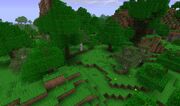 Rainforest |
Seasonal Forest |
Temperature: >97% |
Seasonal Forests spawn with a temperature of 97% or greater, and a rainfall value between 45% and 90%. They are commonly found between forest and rain forests, and near plains biomes. They are identical to forests, except they have fewer trees and are capable of spawning only oak trees. They have a little bit of tall grass. |
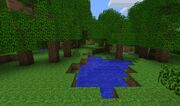 Seasonal Forest |
Ice Desert |
Temperature: 0.0 |
An unused biome before Beta 1.8 that was in the code but never implemented into the temperature/rainfall table and thus did not actually generate. It was a biome of sand with snow on top of it and had snowfall and ice (the player can create something similar using the buffet world option and choosing the snowy beach biome). |
 Ice Desert Biome |
Shrubland |
Temperature: >50%, <97% |
A biome with few trees and no tall grass. It is identical to the savanna biome. It is one of the smallest biomes in the game and spawns only if the temperature is between 50% and 97%, and the rainfall value is below 35% and therefore too little to generate a forest. |
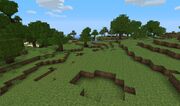 Shrubland |
The Nether
The Nether is considered a different dimension. All biomes in this dimension are dry and it is not possible to place water in these biomes, though ice can still be placed.
| Biome Name and ID | Features | Description | Screenshot | |
|---|---|---|---|---|
Nether Wastes 8 |
Temperature: 2.0 Netherrack, Glowstone, Soul Sand, Nether Quartz Ore, Ghasts, Blazes, Zombified Piglins, Nether Fortresses, Wither Skeletons, Lava, Magma cubes, Gravel, Magma Blocks, Bastion Remnants, Ruined Portals, Piglins,Nether Gold Ore |
This is one of the biomes used to generate the Nether. Within this biome mobs such as ghasts, packs of piglins, zombified piglins and the occasional magma cubes and endermen spawn. Certain structures, such as Nether quartz ore & glowstone veins, and Nether fortresses generate only in the Nether. Water lakes (and other Overworld structures) can still generate if the Nether is used in a superflat preset. Beds explode when used in this biome. |
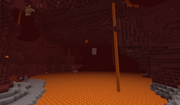 Nether Wastes, formerly called "Nether" | |
| Temperature: 2.0
Netherrack, Glowstone, Soul Sand, Stone, Water, Lava, Gravel, Nether fortresses (when generated through Buffet mode) | ||||
| Temperature: 2.0
Netherrack, Lava, Water, Gravel, Soul Sand, Zombified Piglin, Ghast, Magma Cube (when generated in overworld)[Bedrock Edition only] | ||||
Soul Sand Valley 170 |
Temperature: 2.0
Soul Sand, Soul Soil, Soul Fire, Netherrack, Basalt in Basalt pillars, Bone Blocks in Nether fossils, Ghast, Skeleton, Endermen, Bastion Remnants, Ruined Portals |
The soul sand valley is a large grotto that is extensive and cuts through the Nether's usual terrain. Notable features of the biome are exposed nether fossils in various shapes and sizes, large amounts of lava, blue fog, large spires made of basalt, soul fire, and the occasional Nether fortress or Bastion remnant. The biome itself consists of soul sand, basalt and soul soil.
This biome is extremely dangerous to traverse due to the combination of ghasts and skeletons spawning here and soul sand slowing down the player's movement speed, making it easy for a player to get overwhelmed by projectile attacks. In addition, ghasts fireballs impacting soul sand or soul soil can create soul fire, which is more harmful than regular fire if players get caught in it. It is recommended to avoid this biome unless players have sufficient equipment/strategies to navigate the terrain. The Soul Speed enchantment is especially helpful for traveling through this biome. |
Soul Sand Valley | |
Crimson Forest 171 |
Temperature: 2.0
Crimson Nylium, Crimson Fungus, Warped Fungus, Crimson Roots, Glowstone, Weeping Vines, Huge Crimson Fungus, Nether Wart Blocks, Shroomlight, Hoglins, Piglins, Zombified Piglins, Bastion Remnants, Ruined Portals |
The Crimson Forest is a “red” crimson-themed biome, with warped and crimson fungus as well as huge crimson fungus scattered around the environment.
There are huge fungus structures that contain weeping vines hanging off them and may also have a few blocks of shroomlight. The floor of the biome is covered in crimson nylium, with crimson roots growing. Occasional patches of netherrack and red nether wart blocks are found scattered throughout the biome. In the ceiling, apart from glowstone clusters, there are sparse nether wart block stalactites with vines growing. Piglins, zombified piglins and hoglins naturally spawn in this biome. As long as players equip at least one piece of gold armor, piglins should not cause any trouble. Hoglins can also be repelled by staying close to warped fungus. However, without these countermeasures, this biome can be fairly hostile to navigate. Nevertheless, the abundance of hoglins in this biome makes it a great source of food in the Nether, and the high population of piglins makes this biome an ideal location to barter with them. |
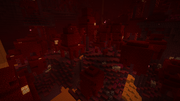 Crimson Forest | |
Warped Forest 172 |
Temperature: 2.0
Warped Nylium, Crimson Fungus, Warped Fungus, Warped Roots, Nether Sprouts, Huge Warped Fungus, Warped Wart Blocks, Shroomlight, Enderman, Bastion Remnants, Ruined Portals |
The warped forest is a dense, “cyan” warped-themed biome, with warped and crimson fungus as well as huge warped fungus scattered around.
The huge fungus structures may have a few blocks of shroomlight scattered around them. The floor of the biome is covered in warped nylium, with warped roots and nether sprouts growing. Occasional patches of raw netherrack and warped wart blocks can be found scattered throughout the biome. Apart from Striders, Endermen are the only mobs that spawn in this biome, making the warped forest an ideal location to collect ender pearls to access the End. This biome is also a relatively safe place to reside in the Nether, due to the fact that no hostile mobs spawn here. However, do note that other hostile mobs can still spawn from Bastion remnants that generate here, as well as from Nether fortresses that have cut into a warped forest after generating in another biome. |
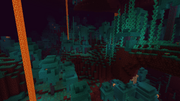 Warped Forest | |
Basalt Deltas 173 |
Temperature: 2.0
Basalt, Blackstone, Netherrack, Lava, Magma Cubes, Striders, Ghasts, Ruined Portals |
A gray biome, the basalt deltas are said to be the remnant of ancient volcanic eruptions.
The ground consists of basalt and blackstone blocks, with small patches of netherrack and pools of lava. The shape of the terrain is chaotic and uneven, making it somewhat difficult to traverse and build on. Unlike the other biomes in the Nether, Bastion remnants do not generate in basalt deltas. When this biome borders a lava ocean, clusters of basalt form near the coast. Magma cubes have a high spawn rate in this biome, making the Basalt Deltas the best place to farm Magma Cream. This biome also contains a much higher abundance of blackstone compared to other Nether biomes. |
 Basalt Deltas |
The End
The End is considered a different dimension. The water is lilac.[Bedrock Edition only]
| Biome Name and ID | Features | Description | Screenshot |
|---|---|---|---|
The End 9 |
Temperature: 0.5 End Stone, Endermen, Obsidian, End Crystals, Ender Dragon, End gateway portal, Void |
This biome is used to generate the circle of radius 1000 centered at the 0,0 coordinates in the End. The End central island is generated at the center of this circle, and it's surrounded by a complete vacuum all the way to the edge of the biome. Most of the End features are exclusive to that island, including the ender dragon, the obsidian pillars, the End Crystals, the 5x5 spawn platform, the exit portal and the 20 central End gateways. Large amounts of endermen spawn in this biome. It does not rain or snow in this biome unlike the other low-temperature biomes. The outer islands in the End can be accessed using the End gateway portal after the ender dragon has been defeated. If the biome is used for a superflat world, the sky appears nearly black and an ender dragon spawns at the 0,0 coordinates in the Overworld. Only endermen spawn at night. |
 The End |
Small End Islands 40 |
Temperature: 0.5 |
Generates as part of the outer islands of the End. This biome represents the empty expanse between the larger islands, populated only by the smaller, circular islands. |  Small End Islands |
End Midlands 41 |
Temperature: 0.5 End stone, Endermen, End gateway portals, End Cities, Shulkers |
Generates as part of the outer islands of the End. This biome represents the gradual slope from the hilltops of each island down to the cliffs around the edge. End cities generate here, but chorus trees do not. |  End Midlands |
End Highlands 42 |
Temperature: 0.5 End Stone, Endermen, Chorus Plants, End Cities, Shulkers, End gateway portals |
Generates as part of the outer islands of the End. This biome represents the hilltops of each island, and is the only biome in the End where both chorus trees and end cities generate. |  End Highlands |
End Barrens 43 |
Temperature: 0.5 |
Generates as part of the outer islands of the End. This biome represents the outer rims of each island, with steep cliffs below the edge. Neither end cities nor chorus trees generate in this biome. |  End Barrens |
Upcoming Biomes
Biome IDs
Each type of biome has its own biome ID, shown in the following tables.
| Name | Resource location | Numeric ID |
|---|---|---|
| The Void | the_void
|
0 |
| Plains | plains
|
1 |
| Sunflower Plains | sunflower_plains
|
2 |
| Snowy Plains | snowy_plains
|
3 |
| Ice Spikes | ice_spikes
|
4 |
| Desert | desert
|
5 |
| Swamp | swamp
|
6 |
| Mangrove Swamp | mangrove_swamp
|
7 |
| Forest | forest
|
8 |
| Flower Forest | flower_forest
|
9 |
| Birch Forest | birch_forest
|
10 |
| Dark Forest | dark_forest
|
11 |
| Old Growth Birch Forest | old_growth_birch_forest
|
12 |
| Old Growth Pine Taiga | old_growth_pine_taiga
|
13 |
| Old Growth Spruce Taiga | old_growth_spruce_taiga
|
14 |
| Taiga | taiga
|
15 |
| Snowy Taiga | snowy_taiga
|
16 |
| Savanna | savanna
|
17 |
| Savanna Plateau | savanna_plateau
|
18 |
| Windswept Hills | windswept_hills
|
19 |
| Windswept Gravelly Hills | windswept_gravelly_hills
|
20 |
| Windswept Forest | windswept_forest
|
21 |
| Windswept Savanna | windswept_savanna
|
22 |
| Jungle | jungle
|
23 |
| Sparse Jungle | sparse_jungle
|
24 |
| Bamboo Jungle | bamboo_jungle
|
25 |
| Badlands | badlands
|
26 |
| Eroded Badlands | eroded_badlands
|
27 |
| Wooded Badlands | wooded_badlands
|
28 |
| Meadow | meadow
|
29 |
| Cherry Grove | cherry_grove
|
30 |
| Grove | grove
|
31 |
| Snowy Slopes | snowy_slopes
|
32 |
| Frozen Peaks | frozen_peaks
|
33 |
| Jagged Peaks | jagged_peaks
|
34 |
| Stony Peaks | stony_peaks
|
35 |
| River | river
|
36 |
| Frozen River | frozen_river
|
37 |
| Beach | beach
|
38 |
| Snowy Beach | snowy_beach
|
39 |
| Stony Shore | stony_shore
|
40 |
| Warm Ocean | warm_ocean
|
41 |
| Lukewarm Ocean | lukewarm_ocean
|
42 |
| Deep Lukewarm Ocean | deep_lukewarm_ocean
|
43 |
| Ocean | ocean
|
44 |
| Deep Ocean | deep_ocean
|
45 |
| Cold Ocean | cold_ocean
|
46 |
| Deep Cold Ocean | deep_cold_ocean
|
47 |
| Frozen Ocean | frozen_ocean
|
48 |
| Deep Frozen Ocean | deep_frozen_ocean
|
49 |
| Mushroom Fields | mushroom_fields
|
50 |
| Dripstone Caves | dripstone_caves
|
51 |
| Lush Caves | lush_caves
|
52 |
| Deep Dark | deep_dark
|
53 |
| Nether Wastes | nether_wastes
|
54 |
| Warped Forest | warped_forest
|
55 |
| Crimson Forest | crimson_forest
|
56 |
| Soul Sand Valley | soul_sand_valley
|
57 |
| Basalt Deltas | basalt_deltas
|
58 |
| The End | the_end
|
59 |
| End Highlands | end_highlands
|
60 |
| End Midlands | end_midlands
|
61 |
| Small End Islands | small_end_islands
|
62 |
| End Barrens | end_barrens
|
63 |
| Name | Resource location | Numeric ID |
|---|---|---|
| Ocean | ocean
|
0 |
| Legacy Frozen Ocean | legacy_frozen_ocean
|
10 |
| Deep Ocean | deep_ocean
|
24 |
| Frozen Ocean | frozen_ocean
|
46 |
| Deep Frozen Ocean | deep_frozen_ocean
|
47 |
| Cold Ocean | cold_ocean
|
44 |
| Deep Cold Ocean | deep_cold_ocean
|
45 |
| Lukewarm Ocean | lukewarm_ocean
|
42 |
| Deep Lukewarm Ocean | deep_lukewarm_ocean
|
43 |
| Warm Ocean | warm_ocean
|
40 |
| Deep Warm Ocean | deep_warm_ocean
|
41 |
| River | river
|
7 |
| Frozen River | frozen_river
|
11 |
| Beach | beach
|
16 |
| Stony Shore | stone_beach
|
25 |
| Snowy Beach | cold_beach
|
26 |
| Forest | forest
|
4 |
| Wooded Hills | forest_hills
|
18 |
| Flower Forest | flower_forest
|
132 |
| Birch Forest | birch_forest
|
27 |
| Birch Forest Hills | birch_forest_hills
|
28 |
| Old Growth Birch Forest | birch_forest_mutated
|
155 |
| Tall Birch Hills | birch_forest_hills_mutated
|
156 |
| Dark Forest | roofed_forest
|
29 |
| Dark Forest Hills | roofed_forest_mutated
|
157 |
| Jungle | jungle
|
21 |
| Jungle Hills | jungle_hills
|
22 |
| Modified Jungle | jungle_mutated
|
149 |
| Sparse Jungle | jungle_edge
|
23 |
| Modified Jungle Edge | jungle_edge_mutated
|
151 |
| Bamboo Jungle | bamboo_jungle
|
48 |
| Bamboo Jungle Hills | bamboo_jungle_hills
|
49 |
| Taiga | taiga
|
5 |
| Taiga Hills | taiga_hills
|
19 |
| Taiga Mountains | taiga_mutated
|
133 |
| Snowy Taiga | cold_taiga
|
30 |
| Snowy Taiga Hills | cold_taiga_hills
|
31 |
| Snowy Taiga Mountains | cold_taiga_mutated
|
158 |
| Old Growth Pine Taiga | mega_taiga
|
32 |
| Giant Tree Taiga Hills | mega_taiga_hills
|
33 |
| Old Growth Spruce Taiga | redwood_taiga_mutated
|
160 |
| Giant Spruce Taiga Hills | redwood_taiga_hills_mutated
|
161 |
| Mushroom Fields | mushroom_island
|
14 |
| Mushroom Field Shore | mushroom_island_shore
|
15 |
| Swamp | swampland
|
6 |
| Swamp Hills | swampland_mutated
|
134 |
| Savanna | savanna
|
35 |
| Savanna Plateau | savanna_plateau
|
36 |
| Windswept Savanna | savanna_mutated
|
163 |
| Shattered Savanna Plateau | savanna_plateau_mutated
|
164 |
| Plains | plains
|
1 |
| Sunflower Plains | sunflower_plains
|
129 |
| Desert | desert
|
2 |
| Desert Hills | desert_hills
|
17 |
| Desert Lakes | desert_mutated
|
130 |
| Snowy Plains | ice_plains
|
12 |
| Snowy Mountains | ice_mountains
|
13 |
| Ice Spikes | ice_plains_spikes
|
140 |
| Windswept Hills | extreme_hills
|
3 |
| Windswept Forest | extreme_hills_plus_trees
|
34 |
| Windswept Gravelly Hills | extreme_hills_mutated
|
131 |
| Gravelly Mountains+ | extreme_hills_plus_trees_mutated
|
162 |
| Mountain Edge | extreme_hills_edge
|
20 |
| Badlands | mesa
|
37 |
| Badlands Plateau | mesa_plateau
|
39 |
| Modified Badlands Plateau | mesa_plateau_mutated
|
167 |
| Wooded Badlands | mesa_plateau_stone
|
38 |
| Modified Wooded Badlands Plateau | mesa_plateau_stone_mutated
|
166 |
| Eroded Badlands | mesa_bryce
|
165 |
| Meadow | meadow
|
186 |
| Grove | grove
|
185 |
| Snowy Slopes | snowy_slopes
|
184 |
| Jagged Peaks | jagged_peaks
|
182 |
| Frozen Peaks | frozen_peaks
|
183 |
| Stony Peaks | stony_peaks
|
189 |
| Lush Caves | lush_caves
|
187 |
| Dripstone Caves | dripstone_caves
|
188 |
| Deep Dark | deep_dark
|
190 |
| Mangrove Swamp | mangrove_swamp
|
191 |
| Nether Wastes | hell
|
8 |
| Crimson Forest | crimson_forest
|
179 |
| Warped Forest | warped_forest
|
180 |
| Soul Sand Valley | soulsand_valley
|
178 |
| Basalt Deltas | basalt_deltas
|
181 |
| The End | the_end
|
9 |
| Cherry Grove | cherry_grove
|
192 |
Worldpainter Scripting Biomes tolevels:
| Name | Namespaced ID | Numeric ID |
|---|---|---|
| Ocean | BIOME_OCEAN
|
0 |
| Deep Ocean | BIOME_DEEP_OCEAN
|
24 |
| Frozen Ocean | BIOME_FROZEN_OCEAN
|
10 |
| Deep Frozen Ocean | BIOME_DEEP_FROZEN_OCEAN
|
50 |
| Cold Ocean | BIOME_COLD_OCEAN
|
46 |
| Deep Cold Ocean | BIOME_DEEP_COLD_OCEAN
|
49 |
| Lukewarm Ocean | BIOME_LUKEWARM_OCEAN
|
45 |
| Deep Lukewarm Ocean | BIOME_DEEP_LUKEWARM_OCEAN
|
48 |
| Warm Ocean | BIOME_WARM_OCEAN
|
44 |
| Deep Warm Ocean | BIOME_DEEP_WARM_OCEAN
|
47 |
| River | BIOME_RIVER
|
7 |
| Frozen River | BIOME_FROZEN_RIVER
|
11 |
| Beach | BIOME_BEACH
|
16 |
| Stone Shore | BIOME_STONE_SHORE
|
25 |
| Snowy Beach | BIOME_SNOWY_BEACH
|
26 |
| Forest | BIOME_FOREST
|
4 |
| Wooded Hills | BIOME_WOODED_HILLS
|
18 |
| Flower Forest | BIOME_FLOWER_FOREST
|
132 |
| Birch Forest | BIOME_BIRCH_FOREST
|
27 |
| Birch Forest Hills | BIOME_BIRCH_FOREST_HILLS
|
28 |
| Tall Birch Forest | BIOME_OLD_GROWTH_BIRCH_FOREST
|
155 |
| Tall Birch Hills | BIOME_BIRCH_FOREST_HILLS
|
156 |
| Dark Forest | BIOME_DARK_FOREST
|
29 |
| Dark Forest Hills | BIOME_DARK_FOREST_HILLS
|
157 |
| Jungle | BIOME_JUNGLE
|
21 |
| Jungle Hills | BIOME_JUNGLE_HILLS
|
22 |
| Modified Jungle | BIOME_MODIFIED_JUNGLE
|
149 |
| Jungle Edge | BIOME_JUNGLE_EDGE
|
23 |
| Modified Jungle Edge | BIOME_MODIFIED_JUNGLE_EDGE
|
151 |
| Bamboo Jungle | BIOME_BAMBOO_JUNGLE
|
168 |
| Bamboo Jungle Hills | BIOME_BAMBOO_JUNGLE_HILLS
|
169 |
| Taiga | BIOME_TAIGA
|
5 |
| Taiga Hills | BIOME_TAIGA_HILLS
|
19 |
| Taiga Mountains | BIOME_TAIGA_MOUNTAINS
|
133 |
| Snowy Taiga | BIOME_SNOWY_TAIGA
|
30 |
| Snowy Taiga Hills | BIOME_SNOWY_TAIGA_HILLS
|
31 |
| Snowy Taiga Mountains | BIOME_SNOWY_TAIGA_MOUNTAINS
|
158 |
| Giant Tree Taiga | BIOME_OLD_GROWTH_PINE_TAIGA
|
32 |
| Giant Tree Taiga Hills | BIOME_GIANT_TREE_TAIGA_HILLS
|
33 |
| Giant Spruce Taiga | BIOME_OLD_GROWTH_SPRUCE_TAIGA
|
160 |
| Giant Spruce Taiga Hills | BIOME_GIANT_SPRUCE_TAIGA_HILLS
|
161 |
| Mushroom Fields | BIOME_MUSHROOM_FIELDS
|
14 |
| Mushroom Field Shore | BIOME_MUSHROOM_FIELD_SHORE
|
15 |
| Swamp | BIOME_SWAMP
|
6 |
| Swamp Hills | BIOME_SWAMP_HILLS
|
134 |
| Savanna | BIOME_SAVANNA
|
35 |
| Savanna Plateau | BIOME_SAVANNA_PLATEAU
|
36 |
| Shattered Savanna | BIOME_SHATTERED_SAVANNA
|
163 |
| Shattered Savanna Plateau | BIOME_SHATTERED_SAVANNA_PLATEAU
|
164 |
| Plains | BIOME_PLAINS
|
1 |
| Sunflower Plains | BIOME_SUNFLOWER_PLAINS
|
129 |
| Desert | BIOME_DESERT
|
2 |
| Desert Hills | BIOME_DESERT_HILLS
|
17 |
| Desert Lakes | BIOME_DESERT_LAKES
|
130 |
| Snowy Plains | BIOME_SNOWY_PLAINS
|
12 |
| Snowy Mountains | BIOME_SNOWY_MOUNTAINS
|
13 |
| Ice Spikes | BIOME_ICE_SPIKES
|
140 |
| Windswept Hills | BIOME_WINDSWEPT_HILLS
|
3 |
| Wooded Mountains | BIOME_WOODED_MOUNTAINS
|
34 |
| Gravelly Mountains | BIOME_WINDSWEPT_GRAVELLY_HILLS
|
131 |
| Gravelly Mountains+ | BIOME_MODIFIED_GRAVELLY_MOUNTAINS
|
162 |
| Mountain Edge | BIOME_MOUNTAIN_EDGE
|
20 |
| Badlands | BIOME_BADLANDS
|
37 |
| Badlands Plateau | BIOME_BADLANDS_PLATEAU
|
39 |
| Modified Badlands Plateau | BIOME_MODIFIED_BADLANDS_PLATEAU
|
167 |
| Wooded Badlands Plateau | BIOME_WOODED_BADLANDS_PLATEAU
|
38 |
| Modified Wooded Badlands Plateau | BIOME_MODIFIED_WOODED_BADLANDS_PLATEAU
|
166 |
| Eroded Badlands | BIOME_ERODED_BADLANDS
|
165 |
| Nether Wastes | BIOME_NETHER_WASTES
|
8 |
| Crimson Forest | BIOME_CRIMSON_FOREST
|
171 |
| Warped Forest | BIOME_WARPED_FOREST
|
172 |
| Soul Sand Valley | BIOME_SOUL_SAND_VALLEY
|
170 |
| Basalt Deltas | BIOME_BASALT_DELTAS
|
173 |
| Dripstone Caves | BIOME_DRIPSTONE_CAVES
|
174 |
| Lush Caves | BIOME_LUSH_CAVES
|
175 |
| The End | BIOME_THE_END
|
9 |
| Small End Islands | BIOME_SMALL_END_ISLANDS
|
40 |
| End Midlands | BIOME_END_MIDLANDS
|
41 |
| End Highlands | BIOME_END_HIGHLANDS
|
42 |
| End Barrens | BIOME_END_BARRENS
|
43 |
| The Void | BIOME_THE_VOID
|
127 |
| Cherry grove | BIOME_CHERRY_GROVE
|
246 |
| Mangrove swamp | BIOME_MANGROVE_SWAMP
|
247 |
| Deep Dark | BIOME_DEEP_DARK
|
248 |
| Frozen Peaks | BIOME_FROZEN_PEAKS
|
249 |
| Grove | BIOME_GROVE
|
250 |
| Jagged Peaks | BIOME_JAGGED_PEAKS
|
251 |
| Meadow | BIOME_MEADOW
|
252 |
| Snowy Slopes | BIOME_SNOWY_SLOPES
|
253 |
| Stony Peaks | BIOME_STONY_PEAKS
|
254 |
Biome colors
Achievements
| Icon | Achievement | In-game description | Actual requirements (if different) | Gamerscore earned | Trophy type (PS4) | |
|---|---|---|---|---|---|---|
| PS4 | Other | |||||
| Adventuring Time | Discover 17 biomes. | Visit any 17 biomes. Does not have to be in a single world. | 40G | Silver | ||
| Sail the 7 Seas | Visit all ocean biomes | Visit all ocean biomes except the deep warm ocean/legacy frozen ocean (as they are unused) | 40G | Gold | ||
| Hot tourist destination | Visit all Nether biomes | The achievement can be completed if one visit biomes in different worlds. | 30G | Silver | ||
Advancements
History

An old image of biomes work-in-progress. "To the right of the player is a taiga, to the left is either a forest, or woods, I can’t remember. In the distance is probably tundra." – Notch

The biomes graph prior to Java Edition Beta 1.8, drawn by Notch. Notice the chicken scratch handwriting, as Notch was working quick to try to get the biomes added by the Halloween Update.
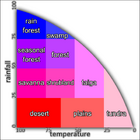
The old biomes graph before Java Edition Beta 1.8, with linear axes.
| Java Edition Alpha | |||||
|---|---|---|---|---|---|
| v1.0.4 | Added Winter Mode. Maps now have a snowy or grassy theme randomly determined when creating the world. | ||||
| v1.2.0 | preview | Added true biomes; they were rain forest, seasonal forest, forest, shrubland, taiga, tundra, savanna, plains, swampland, desert, and frozen desert. | |||
| World saves remained unchanged, other than a change in the hue of the grass. If the player moves into ungenerated chunks, the new biomes would generate. | |||||
| Java Edition Beta | |||||
| 1.6 | Added the Sky Dimension with its own biome. It could be viewed only through the use of modifications. | ||||
| 1.8 | August 18, 2011 | Notch tweeted a screenshot of a revamped river biome. | |||
| September 2, 2011 | Notch teases a screenshot of the new desert biome. | ||||
| September 3, 2011 | Notch teases a screenshot of the new swamp biome. | ||||
| pre1 | Biomes got an overhaul, removing some biomes, such as the tundra and the taiga, and others replaced with nine fractal-based biomes that were a mix of the previous biomes and new biomes. See here for more details. | ||||
| Java Edition | |||||
| 1.0.0 | September 14, 2011 | Notch mentions "snow biomes". | |||
| September 15, 2011 | Notch teases a screenshot of snow biomes. | ||||
| Beta 1.9 Prerelease | Re-added tundra (as ice plains) and added mushroom islands. | ||||
| 1.1 | 11w48a | Re-added snow in taigas. | |||
| 12w01a | Added hills and beaches. | ||||
| Smoothed color transitions between biomes – swampland grass, foliage and water smoothly transition into other biomes. | |||||
| 1.2.1 | January 18, 2012 | Jens Bergensten tweeted a teaser screenshot of a new jungle biome. | |||
| January 19, 2012 | He tweeted another jungle screenshot, showcasing the bright green foliage. | ||||
| 12w03a | Added jungle biome. | ||||
| 12w07a | The Anvil file format was introduced and it allows for biomes to be stored in the world data. In contrast, the Region file format relies on the seed to dynamically calculate biome placement. This would cause biome placement in older worlds to change when the biome generation code was changed. With the current Anvil format, the biome data is stored along with the rest of the world data, meaning it does not change after the world is generated and can be edited by third-party map-editing tools. Furthermore, "edge" biomes allow for biomes to continue to extend beyond the edge chunks of an old world. This allows for smooth transitions in world generation after the generation code changes in an update. | ||||
| 1.3.1 | ? | Hills in forests and deserts are taller. | |||
| Some sections of ice plains biomes were replaced with taiga biomes. | |||||
| 1.6.1 | 13w17a | Water lakes no longer generate in deserts. | |||
| 1.7.2 | August 2, 2013 | Jens tweeted the first image of the mesa biome. He jokingly referred to them as "disco mountains." | |||
| August 7, 2013 | Jens tweeted the first image of a mega taiga, unofficially dubbed the Redwood Forest. The name was changed following 1.7's release. | ||||
| August 9, 2013 | Jens tweeted the first image of a stone beach, which was then referred to as a "cliff" biome. | ||||
| 13w36a | Mesa, mega taiga, roofed forest, birch forest, savanna, extreme hills+, deep ocean and snowless taiga biomes were added as well as variations for many of the biomes. Biomes were also separated by temperature, and snowing was added to extreme hills. | ||||
| Biomes avoid getting placed next to a biome that is too different from itself, temperature-wise. | |||||
| The frozen ocean and extreme hills edge biomes no longer generate naturally. | |||||
| Biome-hopping achievement "Adventuring Time" added, but it was broken until 1.8 making the goal of getting all achievements impossible in 1.7. | |||||
| 13w38b | Marsh-like areas no longer generate in swamp biomes. | ||||
| 13w39a | Red sand now generates in mesa biomes and their variants. | ||||
| 13w43a | Savannas and roofed forest biomes now generate with new logs and leaves. | ||||
| 1.8 | 14w17a | The End's biome name is now "The End" instead of "Sky". | |||
| Adventuring Time is now available without commands. Before, the 38 biomes had to be visited without visiting any other biomes, which made the achievement unavailable because the End has to be visited for its prerequisite, The End?. The "no other biomes" restriction is now lifted. | |||||
| Visiting the frozen ocean and extreme hills edge biomes, which no longer generate since 13w36a, is no longer required for Adventuring Time. | |||||
| 14w26a | Marsh-like areas generate again in swamp biomes. | ||||
| 14w32a | Red sandstone now generates below red sand in mesa biomes and their variants. | ||||
| 1.9 | 15w37a | Added new biome "The Void", which is used in Superflat preset "The Void". | |||
| 16w02a | A lot of M type biomes no longer generate due to MC-95612. | ||||
| 16w03a | M biomes generate again, with the exception of birch forest M (which messes with a lot of other things), see MC-98995. | ||||
| 1.10 | 16w20a | Plains and sunflower plains now have some trees (5% of chunks). 1⁄3 large oaks, 2⁄3 normal oaks. | |||
| Ice plains, ice plains spikes and ice mountains don't spawn passive mobs other than rabbits and the new polar bears anymore. | |||||
| In mesa biomes, terracotta no longer generates more than 15 blocks deep, if the mesa is more than 15 blocks above sea level. In addition to the normal 2 veins of gold ore below Y=32, now attempts to generate 20 veins at elevations between 32 and 79. Also can generate dark oak mineshafts above ground. | |||||
| 1.11 | 16w43a | Birch forest M biomes generate once again. | |||
| 1.13 | 18w06a | The outer islands of the End biome are now divided up into four separate biomes: The End - Floating Islands, The End - Medium island, The End - High island, and The End - Barren island. | |||
| Slightly tweaked the placements of all modified biomes. | |||||
| 18w08a | Added ocean variants, including warm ocean, lukewarm ocean, cold ocean, warm deep ocean, deep lukewarm ocean, deep cold ocean, and deep frozen ocean. | ||||
| Frozen ocean now generates naturally, for the first time since 13w36a. | |||||
| 18w08b | Deep warm ocean biome no longer generate. | ||||
| 18w16a | Biome names are now translatable. | ||||
| Cleaned up several biome names, mainly by adding missing spaces and changing "Biome M" for "Mutated Biome". | |||||
| 18w19a | Names of several biomes are changed. The exact name changes are listed here. | ||||
| pre5 | Changed several biome IDs, mostly to comply with their names, listed here. | ||||
| 1.14 | 18w43a | Added bamboo jungles. | |||
| 1.15 | 19w36a | Biome information now stores Y-coordinates, allowing biomes to be changed based on height. However, this is not yet implemented. | |||
| 1.16 | 20w06a | Implemented vertical biomes in the Nether. | |||
| Added soul sand valleys, crimson forests, and warped forests. | |||||
| "Nether" biome has been renamed to "Nether Wastes". | |||||
Added the /locatebiome command that shows the coordinates of the nearest biomes. | |||||
| 20w15a | Added the Basalt Deltas. | ||||
| 20w16a | Increased the amount of lava lakes in basalt deltas. | ||||
| 20w19a | Tweaked biome distribution in the Nether. | ||||
| 1.16.2 | 20w28a | Experimental Support for Custom Biomes was added. | |||
| Upcoming Java Edition | |||||
| October 3, 2020 | Cave biomes were mentioned at Minecraft Live 2020. | ||||
| 1.17 | 20w46a | Biome-specific sky colors now blend more smoothly. | |||
| 20w49a | Dripstone Caves are added. But don't generate naturally yet. | ||||
| 21w10a | Added the Lush Caves biome, currently only available in the buffet or world type worlds. | ||||
| Pocket Edition Alpha | |||||
| v0.1.0 | Added biomes, these 5 biomes include: snowy tundra, snowy taiga, plains, forest, and desert, from Java Edition Alpha v1.2.0. | ||||
| v0.1.3 | Cacti now generates in deserts. | ||||
| v0.9.0 | build 1 | All biomes as of Java Edition 1.7.2 have been added. These include: Jungles, mesa, roofed forests, savannas, extreme hills, mushroom islands, flower forest, mega taiga, mega spruce taiga, swampland, deep ocean, and legacy frozen ocean (unused). | |||
| v0.9.5 | Added bryce mesa, extreme hills+, and jungle M. | ||||
| v0.10.0 | build 1 | Mesa biomes have gold at every elevation and can generate mineshafts on the surface. | |||
| Water in swamps is tinted dark gray. | |||||
| Huge mushrooms generate in swamps. | |||||
| v0.11.0 | build 1 | Added birch forest M, birch forest hills M, extreme hills M, and extreme hills+ M. | |||
| build 8 | Changed the default biome. | ||||
| build 10 | Increased the amount of gravel on extreme hills M biome. | ||||
| v0.12.1 | build 1 | Added the Nether biome. | |||
| build 10 | Leaves coloring shaders are now used only when the color for a biome actually changes. | ||||
| v0.16.0 | ? | The biomes can now be viewed on maps based on the grass color. | |||
| Pocket Edition | |||||
| 1.0.0 | alpha 0.17.0.1 | Added End biome. | |||
| Bedrock Edition | |||||
| 1.2.0 | ? | Added snow covers to extreme hills. | |||
| 1.4.0 | beta 1.2.14.2 | Added Warm Ocean, Lukewarm Ocean, Cold Ocean, and their deep variant, including new frozen ocean and frozen deep ocean. | |||
Old Frozen Ocean id changed to legacy_frozen_ocean to avoid conflict with new frozen ocean names. | |||||
| 1.9.0 | beta 1.9.0.0 | Added Bamboo Jungle and Bamboo Jungle Hills biome. | |||
| 1.16.0 | beta 1.16.0.51 | Added soul sand valleys, crimson forests, and warped forests. | |||
| beta 1.16.0.57 | Added basalt deltas. | ||||
| 1.16.220 | beta 1.16.220.50 | Added lofty peaks, snow capped peaks, snowy slopes, mountain grove and mountain meadow. | |||
| release | New mountain biomes have been made inaccessible in the full release. | ||||
| Legacy Console Edition | |||||
| TU1 | Added true biomes; they were rain forest, seasonal forest, forest, shrubland, taiga, tundra, savanna, plains, swampland, desert. | ||||
| TU5 | CU1 | 1.00 | Patch 1 | Added swampland, ice plains, extreme hills and ocean biomes. | |
| Removed rain forest, seasonal forest, savanna, shrubland and taiga. | |||||
| TU7 | Re-added tundra (as ice plains) and added Mushroom Islands. | ||||
| TU9 | Re-added beaches and snow in taigas, added hills. | ||||
| Smoothed color transitions between biomes – swampland grass, foliage and water smoothly transition into other biomes. | |||||
| TU12 | Added jungle biome. | ||||
| TU14 | 1.04 | Hills in forests and deserts are taller. | |||
| TU19 | CU7 | 1.12 | Water lakes no longer generate in deserts. | ||
| TU31 | CU19 | 1.22 | Patch 3 | Added mesa, mega taiga, roofed forest, birch forest, forest, savanna, extreme hills+, deep ocean, snowless taiga and 20 technical biomes. | |
| Changed generation of marsh-like areas in swamp and extreme hills biomes. | |||||
Issues
Issues relating to "Biome" are maintained on the bug tracker. Report issues there.
See also
Trivia
- The term biome is analogous to its scientific usage: in real life, a biome is climatically and geographically defined by distinctive communities of plants, animals and soil organisms supported by similar climatic conditions. They are often referred to as ecosystems.[2][3]
- Most biomes in the Overworld are based on real world counterparts. Dark forests, and swamps (and their variants) parallel real world biomes except for the addition of giant mushrooms, which don't exist in reality. Biomes in the Nether and the End obviously don't exist either.
- It is possible for biomes to be a single block in size.[4]
Gallery
The first image of a giant tree taiga, as tweeted by Jeb.
This is the first picture provided of the badlands biome (then called mesa).
The first image of a stone beach (then called cliff) biome, provided by Jeb.
Jeb's first image of the jungle biome.
An above view of a flower forest biome.
A dark forest bordering onto a lake.
A dark forest biome . The stone variants granite, diorite and andesite can also be seen in the cliff.
A large snowy taiga biome, with a beach off to the side.
A mountainous mushroom island.
A frozen ocean biome, with fog obscuring the distance.
A river runs through a flower forest, a sunflower plains, a jungle and a jungle edge biome.
Comparison of giant tree taiga and giant spruce taiga biomes. Note how the giant spruce trees are much thicker.
A cave in a badlands biome.
A river biome in Java Edition 1.16, with visible seagrass in it.
A dark forest that is cut off by water.
The Dripstone Caves biome.
Sunrises and sunsets
References












































